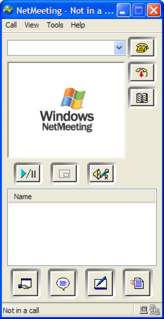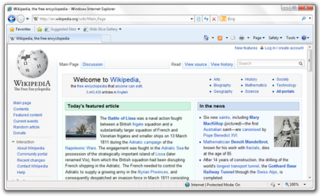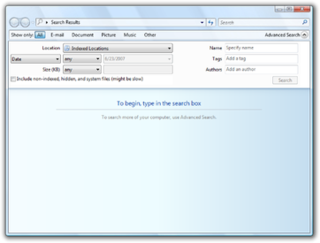Related Research Articles
Windows Virtual PC was a virtualization program for Microsoft Windows. In July 2006, Microsoft released the Windows version free of charge. In August 2006, Microsoft announced the Macintosh version would not be ported to Intel-based Macintosh computers, effectively discontinuing the product as PowerPC-based Macintosh computers would no longer be manufactured.

Windows File Explorer, previously known as Windows Explorer, is a file manager application that is included with releases of the Microsoft Windows operating system from Windows 95 onwards. It provides a graphical user interface for accessing the file systems. It is also the component of the operating system that presents many user interface items on the screen such as the taskbar and desktop. Controlling the computer is possible without Windows Explorer running.
Remote Desktop Protocol (RDP) is a proprietary protocol developed by Microsoft which provides a user with a graphical interface to connect to another computer over a network connection. The user employs RDP client software for this purpose, while the other computer must run RDP server software.

Windows Internet Explorer 7 (IE7) is a web browser for Windows. It was released by Microsoft on October 18, 2006, as the seventh version of Internet Explorer and the successor to Internet Explorer 6. Internet Explorer 7 is part of a long line of versions of Internet Explorer and was the first major update to the browser since 2001. It was the default browser in Windows Vista and Windows Server 2008, as well as Windows Embedded POSReady 2009, and can replace Internet Explorer 6 on Windows XP and Windows Server 2003, but unlike version 6, this version does not support Windows Me, Windows 2000, or earlier versions of Windows. It also does not support Windows 7, Windows Server 2008 R2 or later Windows Versions.

Microsoft NetMeeting is a discontinued VoIP and multi-point videoconferencing client included in many versions of Microsoft Windows. It uses the H.323 protocol for videoconferencing, and is interoperable with OpenH323-based clients such as Ekiga, OpenH323, and Internet Locator Service (ILS) as reflector. It also uses a slightly modified version of the T.120 Protocol for whiteboarding, application sharing, and file transfers.

Windows Vista is a major release of the Windows NT operating system developed by Microsoft. It was the direct successor to Windows XP, which was released five years before, at the time being the longest time span between successive releases of Microsoft Windows desktop operating systems. Development was completed on November 8, 2006, and over the following three months, it was released in stages to computer hardware and software manufacturers, business customers and retail channels. On January 30, 2007, it was released internationally and was made available for purchase and download from the Windows Marketplace; it is the first release of Windows to be made available through a digital distribution platform.

Windows Genuine Advantage (WGA) is an anti-infringement system created by Microsoft that enforces online validation of the licensing of several Microsoft Windows operating systems when accessing several services, such as Windows Update, and downloading Windows components from the Microsoft Download Center. WGA consists of two components: an installable component called WGA Notifications that hooks into Winlogon and validates the Windows license upon each logon and an ActiveX control that checks the validity of the Windows license when downloading certain updates from the Microsoft Download Center or Windows Update. WGA Notifications covers Windows XP and later, with the exception of Windows Server 2003 and Windows XP Professional x64 Edition. The ActiveX control checks Windows 2000 Professional licenses as well.

Skype for Business was an enterprise software application for instant messaging and videotelephony developed by Microsoft as part of the Microsoft Office suite. It is designed for use with the on-premises Skype for Business Server software, and a software as a service version offered as part of Office 365. It supports text, audio, and video chat, and integrates with Microsoft Office components such as Exchange and SharePoint.

Windows Media Center (WMC) is a defunct digital video recorder and media player created by Microsoft. Media Center was first introduced to Windows in 2002 on Windows XP Media Center Edition (MCE). It was included in Home Premium and Ultimate editions of Windows Vista, as well as all editions of Windows 7 except Starter and Home Basic. It was also available on Windows 8 Pro and Windows 8.1 Pro as a paid add-on, before being discontinued in Windows 10, although it can reportedly be unofficially reinstalled using a series of Command Prompt commands.
Compared with previous versions of Microsoft Windows, there are numerous features new to Windows Vista, covering most aspects of the operating system, which include additional management features, new aspects of security and safety, new I/O technologies, new networking features, and new technical features. Windows Vista also removed some features that originated in earlier versions of Windows and included up to Windows XP.

Windows Meeting Space was a peer-to-peer collaboration program developed by Microsoft for Windows Vista as a replacement for Windows NetMeeting and it enables application sharing, collaborative editing, desktop sharing, file sharing, projecting, and simple text-based or ink-based instant messaging across up to 10 users connected to the same network or across the Internet. Meeting Space has the ability to automatically set up an ad hoc wireless network if a connection to a network or the Internet are not available and also enables participants to invite other people to meeting sessions. It is the first application for the new peer-to-peer framework in Windows Vista and hence requires IPv6.

Windows SideShow was a feature by Microsoft introduced in Windows Vista to supply information such as e-mail, instant messages, and RSS feeds from a personal computer to a local or remote peripheral device or display. SideShow was intended to enhance the Windows experience by enabling new mobility scenarios for the Windows platform and by providing power saving benefits as part of Microsoft's broader efforts regarding a mobile initiative.
There are a number of security and safety features new to Windows Vista, most of which are not available in any prior Microsoft Windows operating system release.
In computing, Microsoft's Windows Vista and Windows Server 2008 introduced in 2007/2008 a new networking stack named Next Generation TCP/IP stack, to improve on the previous stack in several ways. The stack includes native implementation of IPv6, as well as a complete overhaul of IPv4. The new TCP/IP stack uses a new method to store configuration settings that enables more dynamic control and does not require a computer restart after a change in settings. The new stack, implemented as a dual-stack model, depends on a strong host-model and features an infrastructure to enable more modular components that one can dynamically insert and remove.

Windows Internet Explorer 8 (IE8) is a web browser for Windows. It was released by Microsoft on March 19, 2009, as the eighth version of Internet Explorer and the successor to Internet Explorer 7. It was the default browser in Windows 7 and Windows Server 2008 R2 and can replace previous versions of Internet Explorer on Windows XP, Windows Server 2003, Windows Vista and Windows Server 2008 but unlike version 7, this version does not support Windows Server 2003 SP1 or an earlier version.
Windows RSS Platform, included in Internet Explorer 7 and later and Windows Vista and later is a platform that exposes feed handling and management to Windows applications. The RSS support in Internet Explorer is built on the Windows RSS Platform.

Windows Search is a content index desktop search platform by Microsoft introduced in Windows Vista as a replacement for both the previous Indexing Service of Windows 2000 and the optional MSN Desktop Search for Windows XP and Windows Server 2003, designed to facilitate local and remote queries for files and non-file items in compatible applications including Windows Explorer. It was developed after the postponement of WinFS and introduced to Windows constituents originally touted as benefits of that platform.
Some of the new features included in Windows 7 are advancements in touch, speech and handwriting recognition, support for virtual hard disks, support for additional file formats, improved performance on multi-core processors, improved boot performance, and kernel improvements. Some of the features which are present in versions up to and including Windows Vista were removed or changed.

Internet Explorer 10 (IE10) is the tenth, and by now, discontinued, version of the Internet Explorer web browser and the successor to Internet Explorer 9, released by Microsoft on September 4, 2012, shortly after the completion of Windows Server 2012. It was the default browser that shipped with Windows 8 and Windows Server 2012 and can replace previous versions of Internet Explorer on Windows 7 and Windows Server 2008 R2 but unlike version 9, this version doesn't support Windows Vista, Windows Server 2008 or earlier.
References
- ↑ Microsoft rebrands Tahiti as SharedView: All about Microsoft blog by Mary Jo Foley
- ↑ Microsoft SharedView v1.0
- ↑ First look at SharedView: Ars Technica
- ↑ SharedView beta: MSgoodies.blogspot.com
- ↑ Is there any live forum, site, etc for MS SharedView?
- ↑ SharedView Update/Issue with IE9 - The SharedView Team Journal - Site Home - MSDN Blogs Archived 2011-08-07 at the Wayback Machine . Blogs.msdn.com (2011-03-18). Retrieved on 2013-08-20.
- ↑ Download Details for ShareView
- ↑ SharedView End of Life Notice